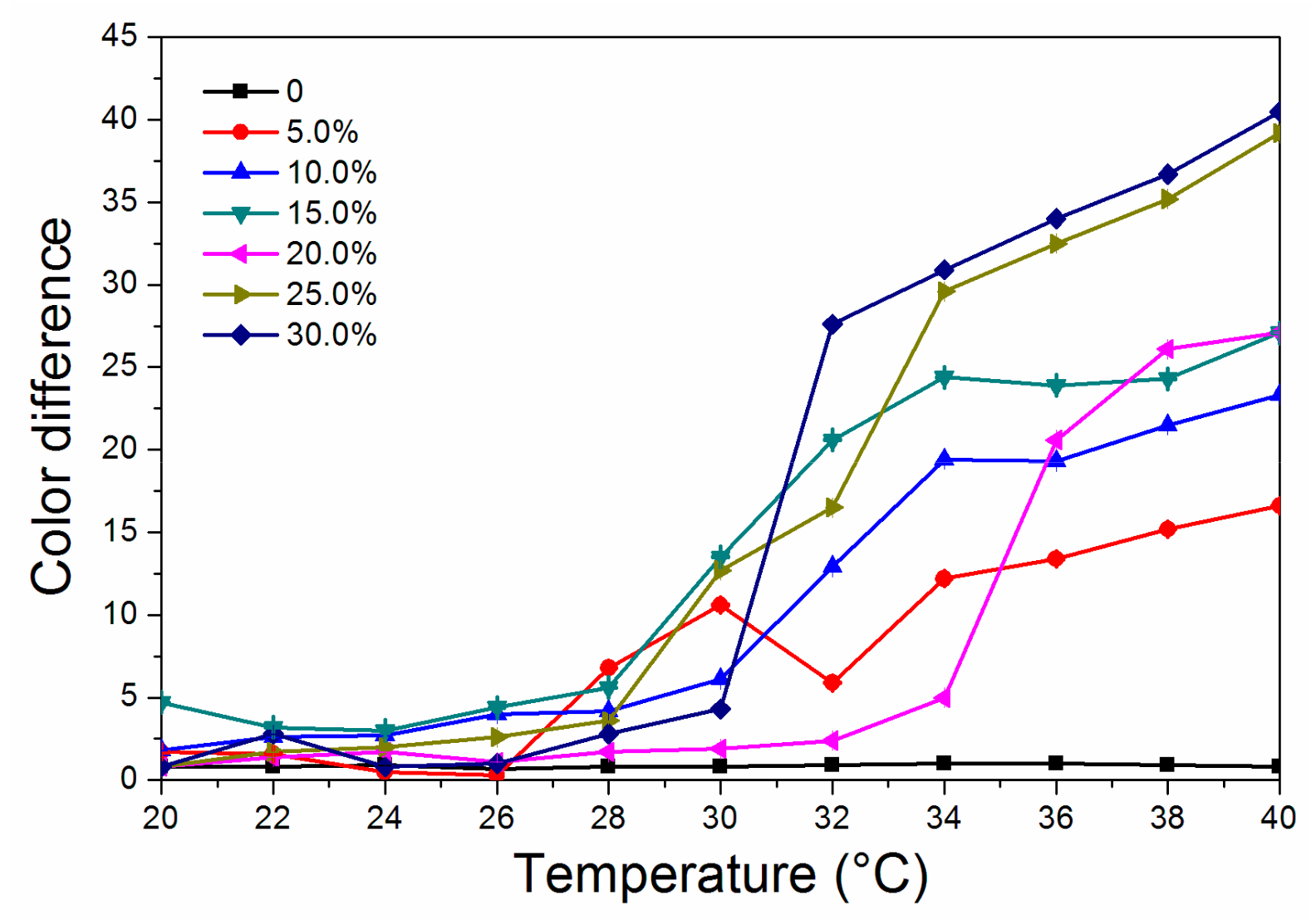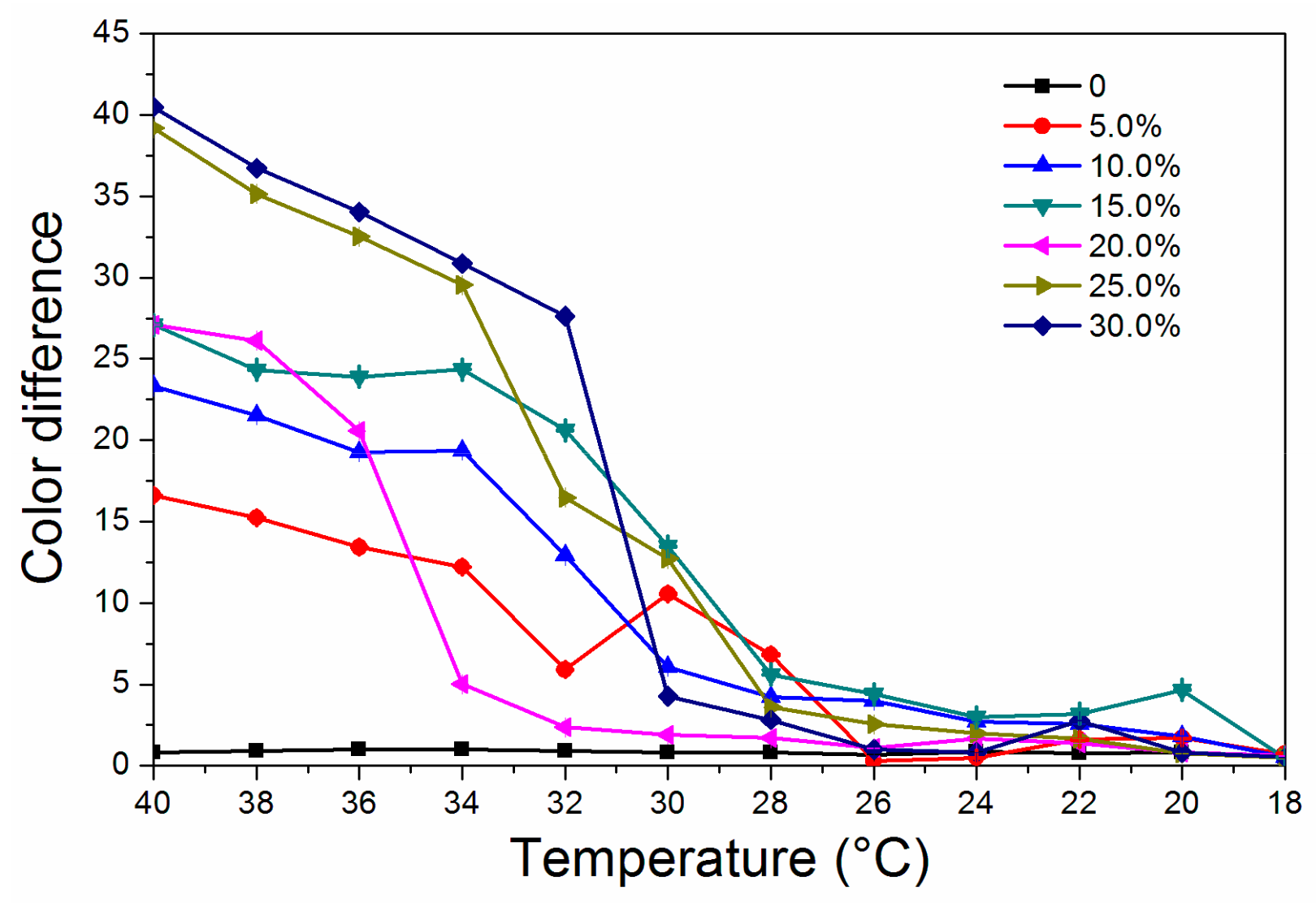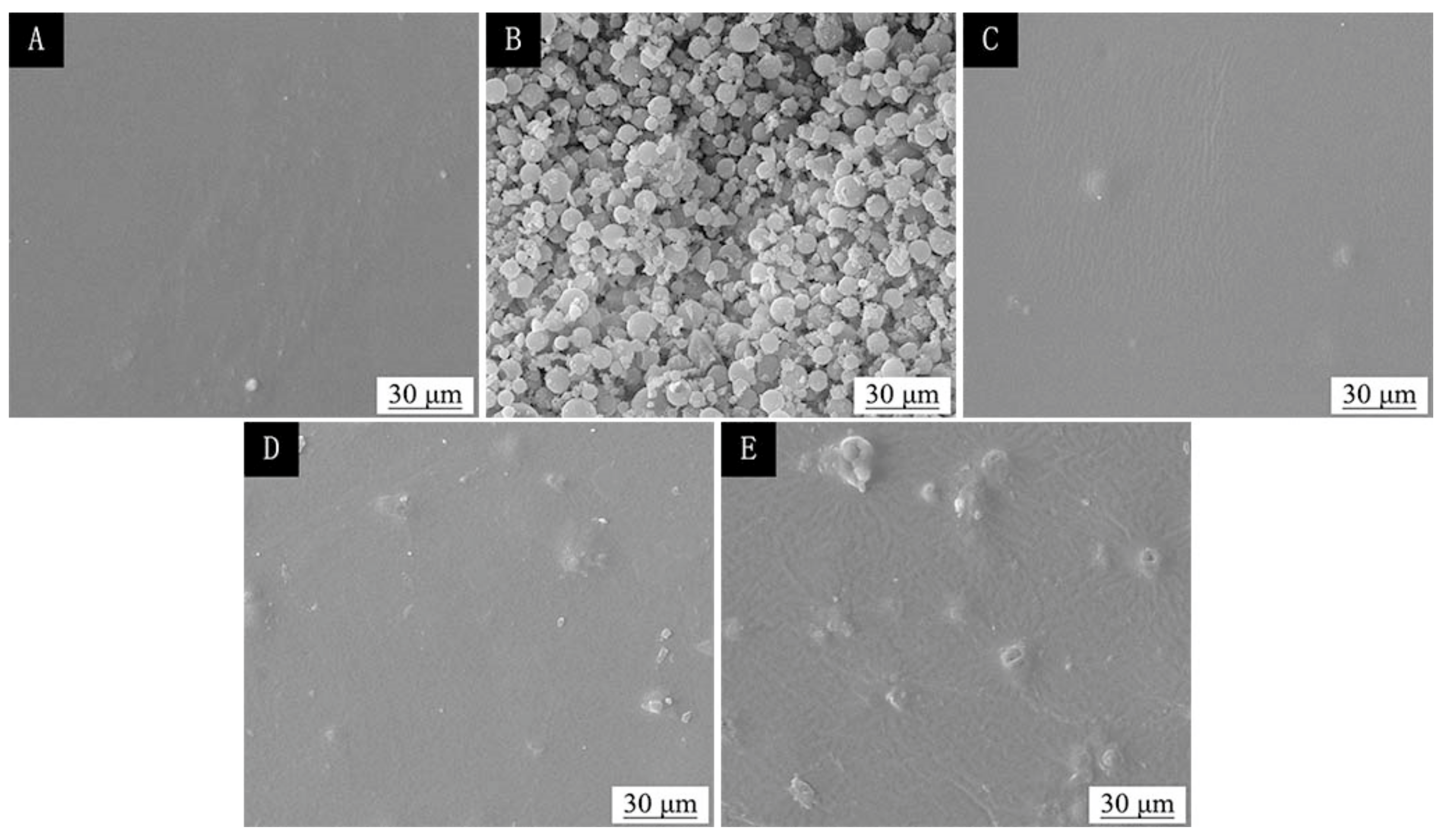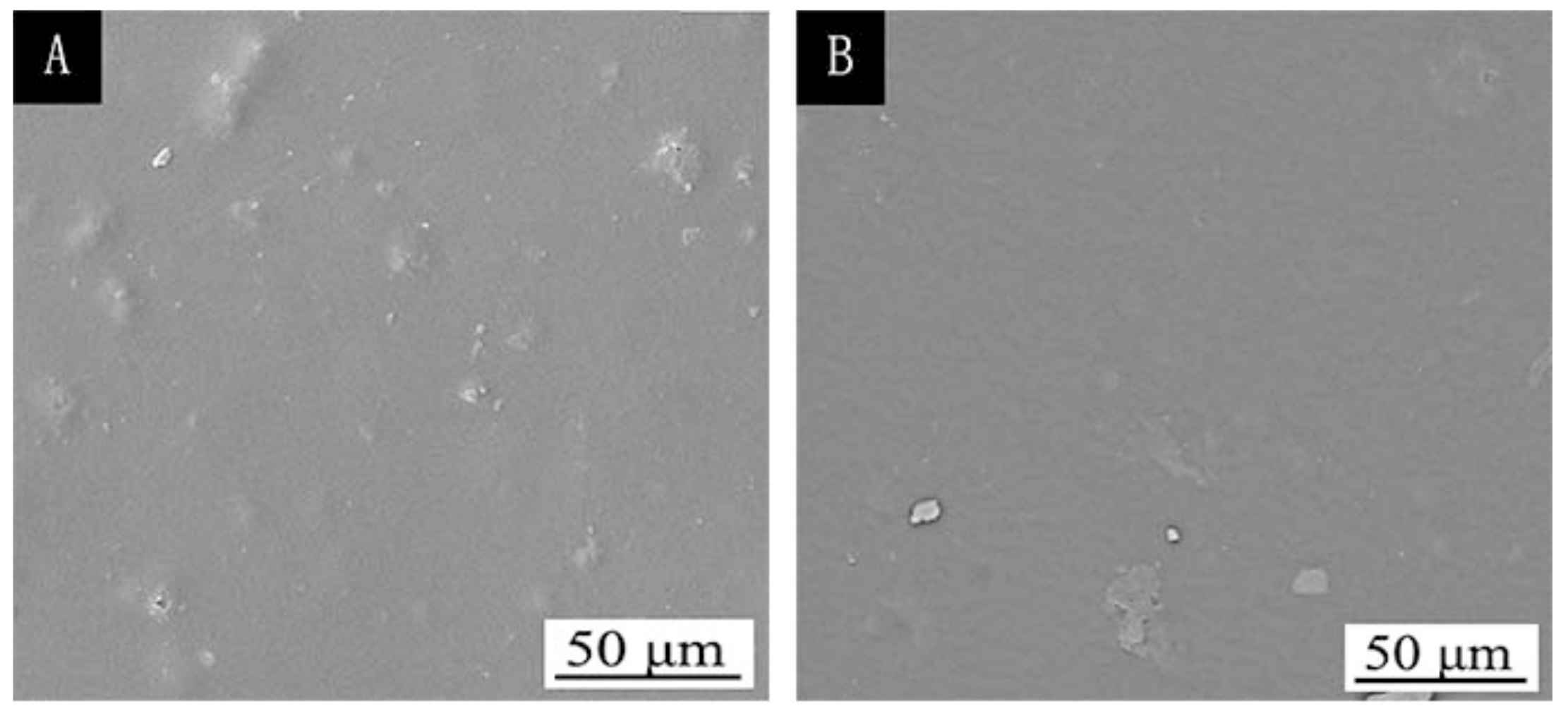Effect of the Concentration of Pigment Slurry on the Film Performances of Waterborne Wood Coatings
Abstract
1. Introduction
2. Experimental Materials and Methods
2.1. Experimental Materials
2.2. Preparation of the Pigment Slurry
2.3. Preparation of Coatings
2.4. Testing and Characterization
3. Results and Discussion
3.1. Effect of Pigment Slurry Concentration of Thermochromic Microcapsules on Optical Properties
3.2. Effect of Pigment Slurry Concentration of Thermochromic Microcapsules on Mechanical Properties
3.3. Effect of Pigment Slurry Concentration of Thermochromic Microcapsules on Chemical Resistance
3.4. Microstructure Analysis
3.5. Stability of Thermochromic of Coatings
4. Conclusions
Author Contributions
Funding
Conflicts of Interest
References
- Tozum, M.S.; Aksoy, S.A.; Alkan, C. Microencapsulation of three-component thermochromic system for reversible color change and thermal energy storage. Fiber. Polym. 2018, 19, 660–669. [Google Scholar] [CrossRef]
- Eranki, A.; Mikhail, A.S.; Negussie, A.H.; Katti, P.S.; Wood, B.J.; Partanen, A. Tissue-mimicking thermochromic phantom for characterization of HIFU devices and applications. Int. J. Hyperther. 2019, 36, 518–529. [Google Scholar] [CrossRef] [PubMed]
- Basnec, K.; Perse, L.S.; Sumiga, B.; Huskic, M.; Meden, A.; Hladnik, A.; Podgornik, B.B.; Gunde, M.K. Relation between colour- and phase changes of a leuco dye-based thermochromic composite. Sci. Rep. 2018, 8, 5511. [Google Scholar] [CrossRef]
- Youn, J.W.; Lee, S.J.; Kim, K.S.; Kim, D.U. Adhesion characteristics of VO2 ink film sintered by intense pulsed light for smart window. Appl. Surf. Sci. 2018, 441, 508–514. [Google Scholar] [CrossRef]
- Jakovljevic, M.; Lozo, B.; Gunde, M.K. Spectroscopic evaluation of the colour play effect of thermochromic liquid crystal printing inks. Color. Technol. 2017, 133, 81–87. [Google Scholar] [CrossRef]
- Wang, G.L.; Xu, W.; Xu, F.; Shen, W.F.; Song, W.J. AgNW/Chinese Xuan paper film heaters for electro-thermochromic paper display. Mater. Res. Express 2017, 4, 116405. [Google Scholar] [CrossRef]
- Khatami, A.; Prova, S.S.; Bagga, A.K.; Ting, M.Y.C.; Brar, G.; Ifa, D.R. Detection and imaging of thermochromic ink compounds in erasable pens using desorption electrospray ionization mass spectrometry. Rapid Commun. Mass Spectrom. 2017, 31, 983–990. [Google Scholar] [CrossRef] [PubMed]
- De Bastiani, M.; Saidaminov, M.I.; Dursun, I.; Sinatra, L.; Peng, W.; Buttner, U.; Mohammed, O.F.; Bakr, O.M. Thermochromic perovskite inks for reversible smart window applications. Chem. Mater. 2017, 29, 3367–3370. [Google Scholar] [CrossRef]
- Vukoje, M.; Miljanic, S.; Hrenovic, J.; Rozic, M. Thermochromic ink-paper interactions and their role in biodegradation of UV curable prints. Cellulose 2018, 25, 6121–6138. [Google Scholar] [CrossRef]
- Kavcic, U.; Mraovic, M.; Bracko, S.; Muck, D. Printed thermochromic displays. Color. Technol. 2019, 135, 60–66. [Google Scholar] [CrossRef]
- Panak, O.; Drzkova, M.; Kailova, N.; Syrovy, T. Colorimetric analysis of thermochromic samples in different forms employing a digital camera. Measurement 2018, 127, 554–564. [Google Scholar] [CrossRef]
- Kim, M.J.; Angupillai, S.; Min, K.; Ramalingam, M.; Son, Y.A. Tuning of the topochemical polymerization of diacetylenes based on an odd/even effect of the peripheral alkyl chain: Thermochromic reversibility in a thin film and a single-component ink for a fountain pen. ACS Appl. Mater. Interfaces 2018, 10, 24767–24775. [Google Scholar] [CrossRef] [PubMed]
- Zhu, X.D.; Liu, Y.; Li, Z.; Wang, W.C. Thermochromic microcapsules with highly transparent shells obtained through in-situ polymerization of urea formaldehyde around thermochromic cores for smart wood coatings. Sci. Rep. 2018, 8, 4015. [Google Scholar] [CrossRef] [PubMed]
- Zhu, X.D.; Liu, Y.; Dong, N.W.; Li, Z. Fabrication and characterization of reversible thermochromic wood veneers. Sci. Rep. 2017, 7, 16933. [Google Scholar] [CrossRef] [PubMed]
- Yan, X.X.; Wang, L.; Qian, X.Y. Effect of high-temperature calcined wheat straw powder after lignin removal on properties of waterborne wood coatings. Coatings 2019, 9, 444. [Google Scholar] [CrossRef]
- Yan, X.X.; Wang, L.; Qian, X.Y. Effect of urea-formaldehyde-coated epoxy microcapsule modification on gloss, toughness and chromatic distortion of acrylic copolymers waterborne coating. Coatings 2019, 9, 239. [Google Scholar] [CrossRef]
- Gaikwad, M.S.; Kusumkar, V.V.; Yemul, O.S.; Hundiwale, D.G.; Mahulikar, P.P. Eco-friendly waterborne coating from bio-based polyester amide resin. Polym. Bull. 2019, 76, 2743–2763. [Google Scholar] [CrossRef]
- Chen, R.D.; Huang, C.F.; Hsu, S.H. Composites of waterborne polyurethane and cellulose nanofibers for 3D printing and bioapplications. Carbohydr. Polym. 2019, 212, 75–88. [Google Scholar] [CrossRef]
- Li, J.; Luo, D.W.; Ma, G.F.; Jia, L.C.; Xu, J.L.; Huang, H.H.; Tong, Z.K.; Lu, Y.Q. Response of Chinese fir seedlings to low phosphorus stress and analysis of gene expression differences. J. For. Res. 2019, 30, 183–192. [Google Scholar] [CrossRef]
- Malm, V.; Straat, M.; Walkenstrom, P. Effects of surface structure and substrate color on color differences in textile coatings containing effect pigments. Text. Res. J. 2014, 84, 125–139. [Google Scholar] [CrossRef]
- SAC. GB/T 1732-93 Determination of Impact Resistance of Film; Standardization Administration of the People’s Republic of China: Beijing, China, 1993. [Google Scholar]
- SAC. GB/T 1720-89 Determination of Adhesion of Film; Standardization Administration of the People’s Republic of China: Beijing, China, 1979. [Google Scholar]
- SAC. GB/T 1733-93 Determination of Resistance to Water of Films; Standardization Administration of the People’s Republic of China: Beijing, China, 1993. [Google Scholar]
- Li, B.Z.; Du, C.Q.; Tan, M.L.; Liu, H.; Essah, E.; Yao, R.M. A modified method of evaluating the impact of air humidity on human acceptable air temperatures in hot-humid environments. Energy Build. 2018, 158, 393–405. [Google Scholar] [CrossRef]
- SAC. GB/T 11186.3-1989 Method of Measurement of Coating Color. Part III: Calculation of Chromatic Aberration; Standardization Administration of the People’s Republic of China: Beijing, China, 1990. [Google Scholar]
- Friskovec, M.; Kulcar, R.; Gunde, M.K. Light fastness and high-temperature stability of thermochromic printing inks. Color. Technol. 2013, 129, 214–222. [Google Scholar] [CrossRef]




| Concentration of Pigment Slurry (%) | Weight of Pigment Slurry (g) | Weight of Waterborne Coating (g) | Weight of Thermochromic Coating (g) |
|---|---|---|---|
| 0 | 0 | 100.0 | 100.0 |
| 5.0 | 5.0 | 95.0 | 100.0 |
| 10.0 | 10.0 | 90.0 | 100.0 |
| 15.0 | 15.0 | 85.0 | 100.0 |
| 20.0 | 20.0 | 80.0 | 100.0 |
| 25.0 | 25.0 | 75.0 | 100.0 |
| 30.0 | 30.0 | 70.0 | 100.0 |
| Concentration of Thermochromic Pigment Slurry (%) | 60° Gloss (%) |
|---|---|
| 0 | 45.5 ± 0.8 |
| 5.0 | 40.9 ± 0.3 |
| 10.0 | 38.4 ± 0.5 |
| 15.0 | 37.2 ± 0.3 |
| 20.0 | 35.7 ± 1.0 |
| 25.0 | 33.2 ± 0.5 |
| 30.0 | 26.1 ± 0.6 |
| Concentration of Thermochromic Pigment Slurry (%) | Impact Resistance (kg·cm) |
|---|---|
| 0 | 5.0 ± 0.1 |
| 5.0 | 4.0 ± 0.1 |
| 10.0 | 4.0 ± 0.1 |
| 15.0 | 4.0 ± 0.1 |
| 20.0 | 4.0 ± 0.1 |
| 25.0 | 5.0 ± 0.1 |
| 30.0 | 6.0 ± 0.1 |
| Concentration of Thermochromic Pigment Slurry (%) | NaCl | Detergent | Ethanol | Red Ink |
|---|---|---|---|---|
| 0 | 0.8 ± 0 | 0.8 ± 0 | 1.0 ± 0 | 1.9 ± 0 |
| 5.0 | 1.1 ± 0 | 1.1 ± 0 | 1.0 ± 0 | 1.9 ± 0 |
| 10.0 | 1.8 ± 0 | 0.5 ± 0 | 0.7 ± 0 | 1.3 ± 0 |
| 15.0 | 1.0 ± 0 | 0.7 ± 0 | 1.2 ± 0 | 1.2 ± 0 |
| 20.0 | 0.9 ± 0 | 1.0 ± 0 | 1.0 ± 0 | 1.3 ± 0 |
| 25.0 | 1.2 ± 0 | 1.3 ± 0 | 1.0 ± 0 | 1.2 ± 0 |
| 30.0 | 0.7 ± 0 | 1.5 ± 0 | 1.3 ± 0 | 1.2 ± 0 |
| Level | Degree of Discoloration | Color Difference |
|---|---|---|
| 0 | no discoloration | ≤1.5 |
| 1 | very slight discoloration | 1.6–3.0 |
| 2 | slight discoloration | 3.1–6.0 |
| 3 | apparent discoloration | 6.1–9.0 |
| 4 | severe discoloration | 9.1–12.0 |
| 5 | complete discoloration | >12.0 |
| Concentration of Thermochromic Pigment Slurry (%) | NaCl (level) | Detergent (level) | Ethanol (level) | Red Ink (level) |
|---|---|---|---|---|
| 0 | 0 | 0 | 0 | 1 |
| 5.0 | 0 | 0 | 0 | 1 |
| 10.0 | 1 | 0 | 0 | 0 |
| 15.0 | 0 | 0 | 0 | 0 |
| 20.0 | 0 | 0 | 0 | 0 |
| 25.0 | 0 | 0 | 0 | 0 |
| 30.0 | 0 | 0 | 0 | 0 |
| Sample | L* | a* | b* | C* | h* | ΔE* |
|---|---|---|---|---|---|---|
| 18 °C | 67.7 ± 0 | 34.6 ± 0 | 26.0 ± 0 | 43.3 ± 0 | 36.9 ± 0 | – |
| Three months at 18 °C | 67.5 ± 0 | 33.7 ± 0 | 27.2 ± 0 | 44.2 ± 0 | 41.2 ± 0 | 1.5 ± 0 |
| 30 °C | 74.4 ± 0 | 22.9 ± 0 | 26.6 ± 0 | 35.1 ± 0 | 49.2 ± 0 | – |
| 30 °C heating 24 h | 73.6 ± 0 | 23.9 ± 0 | 25.5 ± 0 | 36.0 ± 0 | 48.5 ± 0 | 1.7 ± 0 |
| 30 °C heating 48 h | 73.7 ± 0 | 23.8 ± 0 | 25.8 ± 0 | 34.2 ± 0 | 48.6 ± 0 | 1.4 ± 0 |
| 30 °C heating 72 h | 73.9 ± 0 | 22.2 ± 0 | 27.8 ± 0 | 36.4 ± 0 | 50.6 ± 0 | 1.5 ± 0 |
| Sample | L* | a* | b* | C* | h* | ΔE* | Gloss (%) |
|---|---|---|---|---|---|---|---|
| Before ageing | 72.2 ± 0 | 14.1 ± 0 | 36.7 ± 0 | 39.3 ± 0 | 69.8 ± 0 | – | 37.2 ± 0 |
| After ageing | 71.8 ± 0 | 14.7 ± 0 | 39.7 ± 0 | 42.3 ± 0 | 69.5 ± 0 | 3.1 ± 0 | 36.8 ± 0 |
© 2019 by the authors. Licensee MDPI, Basel, Switzerland. This article is an open access article distributed under the terms and conditions of the Creative Commons Attribution (CC BY) license (http://creativecommons.org/licenses/by/4.0/).
Share and Cite
Yan, X.; Chang, Y.; Qian, X. Effect of the Concentration of Pigment Slurry on the Film Performances of Waterborne Wood Coatings. Coatings 2019, 9, 635. https://doi.org/10.3390/coatings9100635
Yan X, Chang Y, Qian X. Effect of the Concentration of Pigment Slurry on the Film Performances of Waterborne Wood Coatings. Coatings. 2019; 9(10):635. https://doi.org/10.3390/coatings9100635
Chicago/Turabian StyleYan, Xiaoxing, Yijuan Chang, and Xingyu Qian. 2019. "Effect of the Concentration of Pigment Slurry on the Film Performances of Waterborne Wood Coatings" Coatings 9, no. 10: 635. https://doi.org/10.3390/coatings9100635
APA StyleYan, X., Chang, Y., & Qian, X. (2019). Effect of the Concentration of Pigment Slurry on the Film Performances of Waterborne Wood Coatings. Coatings, 9(10), 635. https://doi.org/10.3390/coatings9100635




